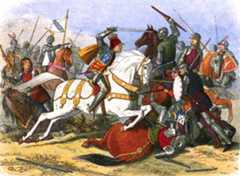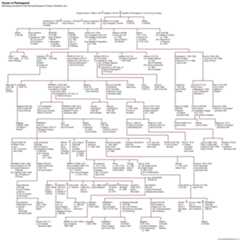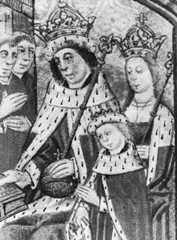Wars of the Roses
Our editors will review what you’ve submitted and determine whether to revise the article.
- World History Encyclopedia - Wars of the Roses
- Warfare History Network - The Wars of the Roses: The Weapons That Defined the English Civil Wars
- Chemistry LibreTexts - The Hundred Years� War
- University of Cambridge - The Wars of the Roses
- Luminarium - The Wars of the Roses (1455�1485)
- Indiana University - The Medieval Review - 14.05.05, Grummitt, A Short History of the Wars of the Roses
- Heritage History - War of the Roses
- Historic UK - The Wars of the Roses
- ABC listen - Artworks - The War of the Roses
- Wars of the Roses - Origins of the Conflict
- BBC Bitesize - The Wars of the Roses
- University of Canterbury - Wars of the Roses
- History Today - The Wars of the Roses: Who Fought and Why?
- The British Academy - The War of the Roses (PDF)
- Open University - OpenLearn - England�s Historic Battlefields: the Wars of the Roses
How did the Wars of the Roses get their name?
The Wars of the Roses were fought between the houses of Lancaster and York for the English throne. The wars were named many years afterward from the supposed badges of the contending parties: the white rose of York and the red rose of Lancaster. Both houses claimed the throne through descent from the sons of Edward III.
What caused the Wars of the Roses?
In the mid-15th century great magnates with private armies dominated the English countryside. Lawlessness was rife and taxation burdensome.Henry VI experienced spells of madness and was dominated by his queen, Margaret of Anjou. In 1453, when Henry lapsed into insanity, a powerful baronial clique installedRichard, duke of York, as protector of the realm. Henry recovered in 1455, reestablishing the authority of Margaret’s party. York took up arms, starting the Wars of the Roses.
How were the Wars of the Roses finally resolved?
Henry Tudor (later Henry VII) defeated and killedRichard III at Bosworth Field on August 22, 1485, bringing the Wars of the Roses to a close. By his marriage to Edward IV’s daughter Elizabeth of York in 1486, Henry united the Yorkist and Lancastrian claims. Henry defeated a Yorkist rising supporting the pretender Lambert Simnel on June 16, 1487, a date that some historians prefer over the traditional 1485 for the termination of the wars.
Wars of the Roses, (1455–85), inEnglish history, the series of dynastic civil wars whose violence and civil strife preceded the strong government of theTudors. Fought between the houses ofLancaster andYork for the English throne, the wars were named many years afterward from the supposed badges of the contending parties: the white rose of York and the red rose of Lancaster.
Competing claims to the throne and the beginning of civil war
Both houses claimed the throne through descent from the sons ofEdward III. Since the Lancastrians had occupied the throne from 1399, the Yorkists might never have pressed a claim but for the nearanarchy prevailing in the mid-15th century. After the death ofHenry V in 1422 the country was subject to the long and factious minority ofHenry VI (August 1422–November 1437), during which the English kingdom was managed by the king’s council, a predominantly aristocratic body. That arrangement, which probably did not accord with Henry V’s last wishes, was not maintained without difficulty. LikeRichard II before him, Henry VI had powerful relatives eager to grasp after power and to place themselves at the head of factions in the state. The council soon became their battleground.
Great magnates with private armies dominated the countryside. Lawlessness was rife and taxation burdensome. Henry later proved to befeckless and simpleminded, subject to spells of madness, and dominated by his ambitious queen,Margaret of Anjou, whose party had allowed the English position in France to deteriorate.
Between 1450 and 1460Richard, 3rd duke of York, had become the head of a great baronial league, of which the foremost members were his kinsmen, the Nevilles, the Mowbrays, and the Bourchiers. Among his principal lieutenants was his nephewRichard Neville, the earl of Warwick, a powerful man in his own right, who had hundreds of adherents among the gentry scattered over 20 counties. In 1453, when Henry lapsed into insanity, a powerful baronial clique, backed by Warwick, installed York, as protector of the realm. When Henry recovered in 1455, he reestablished the authority of Margaret’s party, forcing York to take up arms for self-protection. The first battle of the wars, atSt. Albans (May 22, 1455), resulted in a Yorkist victory and four years of uneasy truce.
A new phase of the civilwar began in 1459 when York,goaded by the queen’s undisguised preparations to attack him, rebelled for the last time. The Yorkists were successful atBlore Heath (September 23) but were scattered after a skirmish atLudford Bridge (October 12). York fled toIreland, and the Lancastrians, in a packed parliament atCoventry (November 1459), obtained a judicial condemnation of their opponents and executed those on whom they could lay hands.

From then on the struggle was bitter. Both parties laid aside their scruples and struck down their opponents without mercy. The coldblooded and calculated ferocity that now entered English political life certainly owed something to the political ideas of the ItalianRenaissance, but, arguably, it was also in part alegacy of the lawless habits acquired by the nobility during the Hundred Years’ War.
In France Warwick regrouped the Yorkist forces and returned toEngland in June 1460, decisively defeating the Lancastrian forces atNorthampton (July 10). York tried to claim the throne but settled for the right to succeed upon the death of Henry. That effectively disinherited Henry’s son, Prince Edward, and caused Queen Margaret to continue her opposition.
Gathering forces in northern England, the Lancastrians surprised and killed York atWakefield in December and then marched south toward London, defeating Warwick on the way at the Second Battle of St. Albans (February 17, 1461). Meanwhile, York’s eldest son andheir,Edward, had defeated a Lancastrian force atMortimer’s Cross (February 2) and marched to relieve London, arriving before Margaret on February 26. The young duke of York was proclaimedKing Edward IV atWestminster on March 4. Then Edward, with the remainder of Warwick’s forces, pursued Margaret north toTowton. There, in the bloodiest battle of the war, the Yorkists won a complete victory. Henry, Margaret, and their son fled toScotland. The first phase of the fighting was over, except for the reduction of a few pockets of Lancastrian resistance.





















